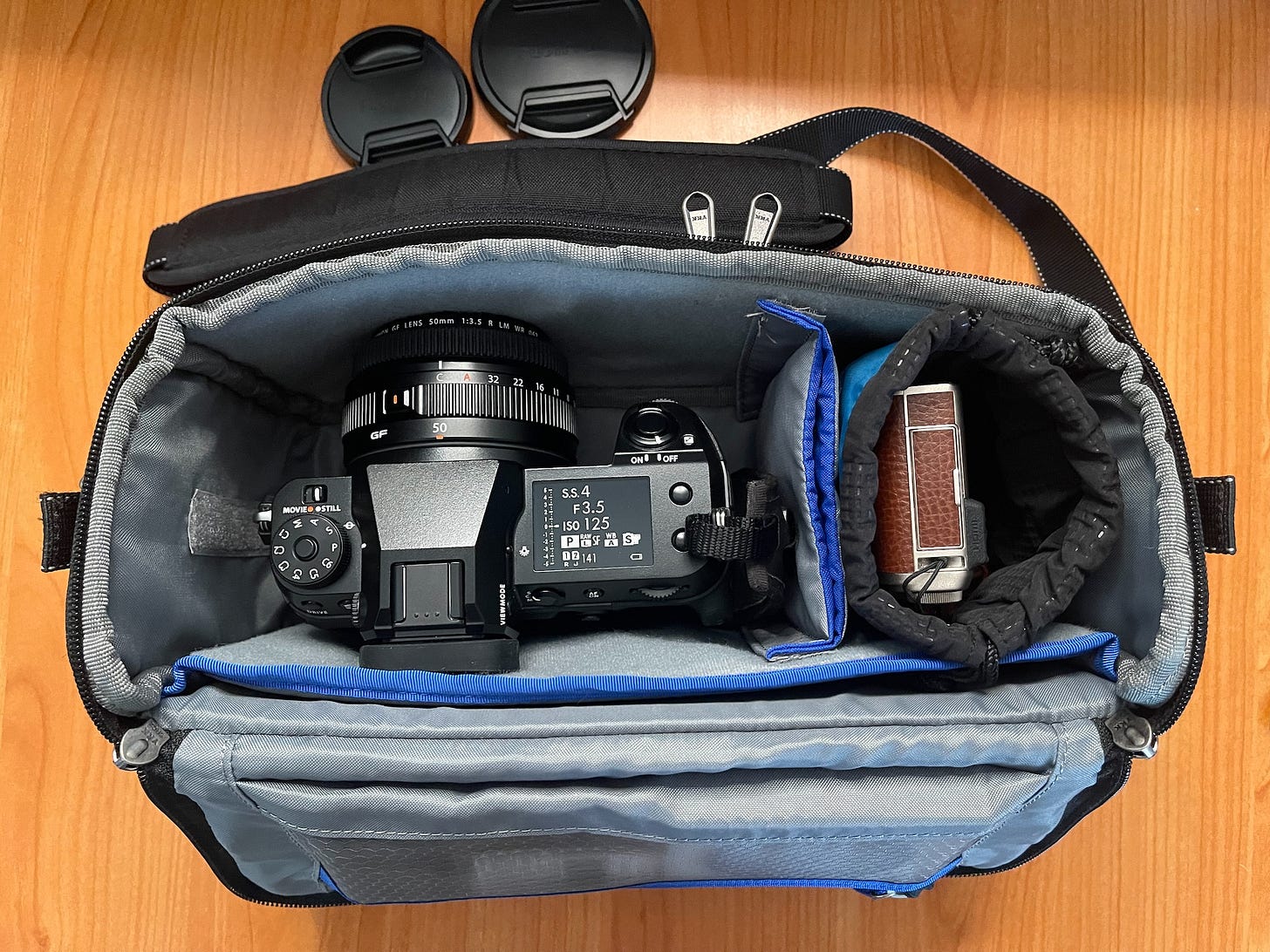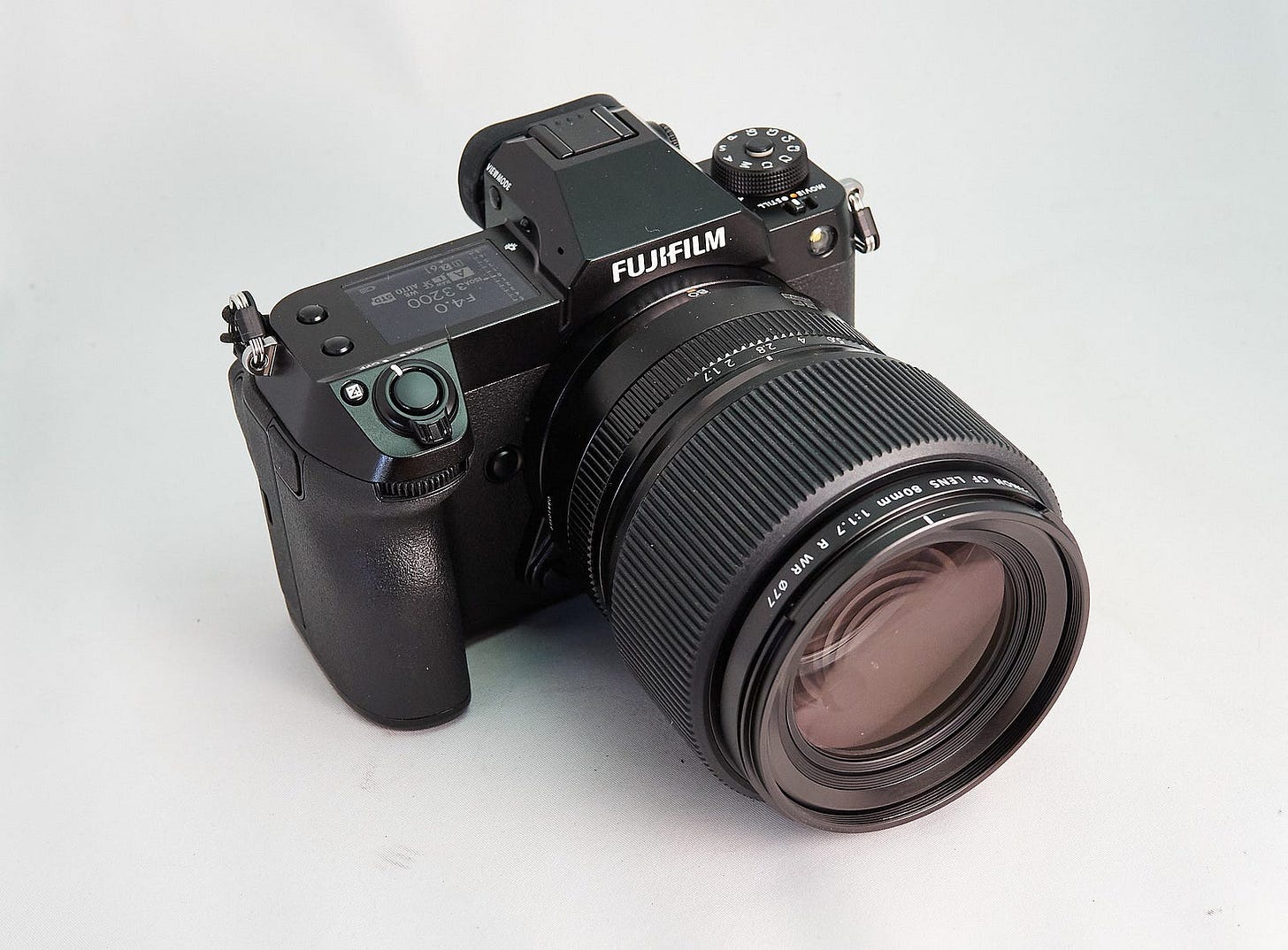What I've Learned After 2 Years of Shooting Medium Format
My adventures with the Fujifilm GFX 100S
In June of 2021, I got my hands on a Fujifilm GFX 100S. Even though it’s about the same size of a DSLR, it packs 102 megapixels via its 43.8 x 32.9mm BSI CMOS sensor. When you nail a shot, the files are amazing.
I had used a Hasselblad in the film days, but this was my first mirrorless medium format. And to be honest, I had a few things to learn.
What we’re going to do in today’s newsletter is step back to July 2021 to an article I published when I first started exploring the GFX 100S. I think it’s interesting to see my point of view then.
In the second half of this newsletter, I’m posting an update including the things I’ve learned over time. And I will talk about the assignment I’m going to use the camera for later this week.
But first, let’s step back to 2021…
My initial thoughts about the GFX100S
Curious About Medium Format? So Was I
The cameras I use are smaller these days. I had a 35mm SLR when film ruled the earth, then a DSLR when digital took over, and now the Fujifilm X100V rangefinder is my most frequent choice.
I like its form factor. It fits nicely in the glovebox when I'm embarking on an adventure. The X100V is a compact and capable companion.
Medium format photography, on the other hand, has always been something that other photographers did. (The term is a carryover from the film days simply meaning that the sensor is bigger than full frame or cropped sensor cameras.) Those artists serious about landscape work or being hired for commercial jobs were the ones who could invest thousands of dollars to capture images with amazing resolution using artillery-like lenses.
That is, until Fujifilm developed the (more) affordable GFX100S system. Now anyone who could afford a top of the line Sony full frame, could go the extra mile and move up to an even bigger sensor. Fujifilm made medium format accessible.
I wanted to try it. So I took the plunge.
The first thing I noticed about the GFX100S was that it's like a big kid. It had many of the same controls, often in similar places, as my more compact X100V. But it's a larger, slightly more clumsy version. It's a man-child of a camera that has a sense of playfulness in a serious body.
The back LCD screen swivels up and down, and to the side. The electronic viewfinder is beautiful to look through. It has all the film simulations that Fuji offers, plus custom exposure modes, twin SD card slots, and even goodies like built-in skin softening for portraits.
Its body is substantial with a hefty grip and big, weighty lenses. Even the "pancake" 50mm f/3.5 filled my entire hand when I held it. It inspires confidence. The GFX has a "don't worry, I got this" vibe to it.
The pictures it produces are good, very good. The GFX100S has all of the Fuji color magic that makes you feel like a better photographer than you really are. The pixel dimensions are equally impressive: 11,648 on the longest side. Compare that to the 6,240 that my X100V records, and I start to think, "Hmm, I have some room for cropping." Viewing the images at 200 percent magnification on a laptop renders a ton of excellent detail. No doubt, the files are awesome.
But now that I've done all that, I don't know what to do next. It's a real commitment to go shooting with it. Compared to the X100V that I just toss in the glovebox, the GFX100S travels in a padded suitcase - nothing casual about that. I feel pressure to perform.
Even on commercial shoots it ups the ante. One client, while watching me unpack it, remarked, "Whoa, what do you have there?"
Clearly, I have more to learn about working with medium format. But there's one thing I can say right now: If you get the opportunity to hold one of these cameras, look through its viewfinder, and take a picture, do it.
In a world of compact everything, it's big, smart, and spectacular. The GFX100S is a pair of shoes that I look forward growing in to.
Two Years Later with the Fujifilm Medium Format

So many things have changed since 2021. And I’m not sure if I’ve grown into these shoes yet, but they are a bit more comfortable.
The thing about medium format photography, which isn’t really that different from full frame mirrorless cameras, is that the body size is manageable, but the lenses will kill you.
In order to accommodate that big sensor, the glass has to be formidable as well, especially if you want a fast maximum aperture. And for a while, I stopped reaching for the GFX all together because the GF 80mm f/1.7 lens was just too big. Sure, it was amazing for portrait assignments. But for everyday shooting, I didn’t want to lug it around.
So I then experimented with a lens adapter that would allow me to use my Nikon full frame optics on the body. They were far more compact, and Fujifilm even has a menu setting for this set up. So why not?
I liked using the Nikon glass for fun, artistic shoots, but the lack of autofocus and the unpredictable results weren’t ideal for assignment work.
Finally, I spotted the GF 50mm f/3.5 R LM WR lens on sale for $499 — a huge discount from its normal $999 list price. This optic had everything I wanted: compact size, click-stop aperture, well-damped manual focus ring, snappy autofocus, and all-weather construction. The 50mm on the medium format sensor worked out to be a 40mm equivalent on full frame, and that’s a focal length I just love.
As soon as I switched to the 50mm, I started using the camera more often. It fits nicely in my Think Tank Mirrorless Mover 25i, which is very discreet. And there’s even enough room for the Fujifilm XF10 with its APS-C sensor and 28mm wide angle lens.
I’ve reclaimed my nimbleosity, and have tremendous fire power packed in the bag.
My lesson after two years is this: Medium format camera bodies can be relatively compact; it’s the lenses that will kill you. Find a good bang-around optic that meets your needs, and you’ll find yourself packing the camera for field work far more often.
My Next GFX Assignment
The ID. Buzz Event in Huntington Beach, CA
The U.S. debut of the long-awaited ID.Buzz is this Friday in Huntington Beach. I’m driving my ID.4 down to So Cal to cover the event.
My brother-in-law and sister have a restored 11-window VW microbus (red & white) that they will be displaying in the car show. That gets me in the door early, and I’ll be able to photograph all of those classic VWs, then cover the unveiling of the U.S. version of the Buzz.
It’s going to be quite a day for me and the GFX! Stay tuned for some pictures.
I use affiliate links for the gear I mention. Same low price for you, and they help support this free newsletter.



Derrick, you are soooo right. It's the lenses that impact size and weight. Ultimately, it's what keeps me coming back to small, manual focus lenses for my full frame. I can fit the camera and multiple lenses into a small bag. Tradeoffs!!
It's great, Derrick, that you came back and gave an update on what transpired -- a lot of us don't offer the follow-ups that people deserve. I see a lot of folks from workshops who've gone down this road, and the next time you talk with them, they don't have much to say about that journey (most end up putting them in the closet, or selling them on eBay or to MPB).